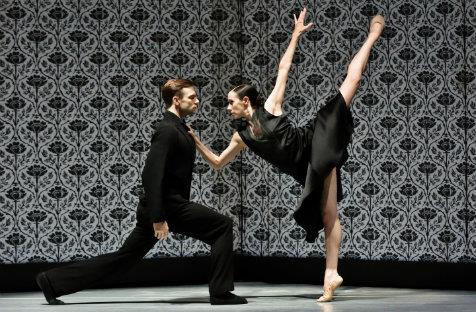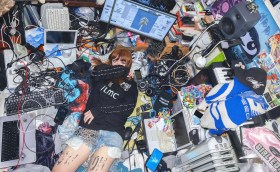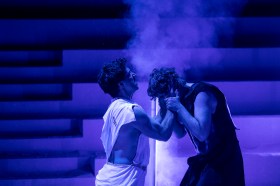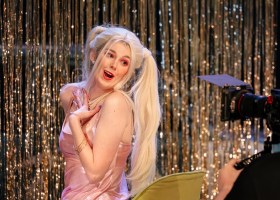A most exciting quadruple bill, very well balanced, that showcases the extraordinary talents of the Nederlands Dans Theater’s dancers. Technically they are superb – refined, extremely virtuosic and full of sinuous fluidity. All this is contrasted with sharp, short, angular movements and the occasional incorporation of speech when required.
We in Sydney are very privileged to have this short Sydney visit, and dance luminaries from around Australia dotted the audience at opening night. The season was one of the major events in Sydney’s dance calendar for this year.
It is important to note is that this is probably the last chance for Australian audiences to see Jiří Kylián’s choreography performed by NDT until at least 2017, as he has just announced the withdrawal of his works, as of 2014, for three years. (Kylián was head of NDT for years and you could say his work is almost the definitive ‘house style’ of the company.)
There is also an Australian link to the company: Danielle Rowe, a former member of the Australian Ballet, is now performing tremendously with NDT.
This live program combines works from two screenings of Nederlands Dans Theater (NDT) performances I have seen previously, and they worked magnificently live on stage. The evening opened with Sweet Dreams, which begins with a female dancer very carefully picking her way over a line of green apples. One of the two Kylián ‘black and white’ ballets in this program, this work could be viewed as rather strange and nightmarish, with Kylián ‘examining the complex world of the human subconscious’. The apples represent temptation and forbidden desire, as in the ‘fall’ in the Garden of Eden. The cast comprises four couples in black corset/bodice leotards and tights or, for the men, black trousers. The snappy lighting is sensational – the couples are mostly divided by square shafts of light that at times look like different levels/platforms on the stage. The apples are used in various ways: sometimes ironic, sometimes comic or serious.
The work features amazing, sculptural, athletic pas de deux and upside down lifts, and also the use of a ramp (at one point a woman is upside down on the ramp and there is a ‘rain’ of apples). Sometimes the choreography is insect-like with almost impossible lifts. Toward the end there is an image of the dancers with their hands, like binoculars, peering at the audience.
This segues straight into Sarabande, which features absolutely stunning, very detailed bell-like period dresses, suspended on wires, mysteriously hanging mid-air. Performed by six men, this powerful dance piece is a testosterone showcase, bursting with barely contained energy. The men wear white tops (at least at first) and in the opening, in the golden light, breathe and ripple like the sea.
A deep Graham plie is favoured and Kylián demands incredible use of a very flexible back. Tiny isolated movements such as fingers fluttering or checking the hold on an ankle are important. Tai- chi like movements are also incorporated. Are there hints of a Maori haka? Sometimes the men are suddenly explosive in their frantic action and we see this in the sweat dripping from the cast. Lighting ranges from almost clear angelic white to Caravaggio- like gloom. At a couple of points the choreography was reminiscent of Graeme Murphy’s work. Amplified groans, thuds, yells, percussive slaps etc are heard as the men crawl, leap, slide, spiral turn… Towards the climax the Bach violin concerto leads to sensational individual solos and a weird laugh at the end. There was also a ‘feminization’ of movement in certain of the solos that was intriguing.
The featured middle work, Sh-Boom I found contrived and artificial. It was supposed to be loads of frothy ‘fun’ but I didn’t really ‘get’ that, although the rest of audience seemed to enjoy it immensely. The opening and closing sequences had blonde Silas Henriksen in white, doing repeated phrases of movement and flashy a toothy grin at us then energetically leading the ensemble.
I was reminded in parts of Matthew Bourne’s Town and Country and with the guys in their white underpants are we meant to think of his Spitfire? Or is it that the work is stripped back and very revealing? There are also possible allusions, chillingly so, to the musical Cabaret. Created in 1994, this is a supposedly playful work set to the music of Vera Lynn and Stan Freberg, golden oldies where men in love attempt to impress women. It has apparently been updated and revised several times.
There is a sharp, angular pas de quatre for the women reminiscent of Macmillan’s Las Hermanas. It also features a magnificent black and white jacketed John/Marcia routine delineating the breakup of a relationship (done by one performer) with a large microphone. This work also features a magnificent nude male solo with discreet, gloomy, hand-held bobbing lighting and strategic placement of a saucepan. Confetti rained on the audience at the end.
To the haunting, driving music of Philip Glass, in the ghostlike, dreamlike Shoot the Moon, the final work of the evening, we catch glimpses of the intimate life of three couples (possibly three generations?). The pas de deux are visually stunning with some amazing, very unusual and difficult lifts and poses. The lyrical, atmospheric lighting is superb. In some ways it has a despairing Chekhovian atmosphere at certain points. I also had the feeling there was a possible Pina Bausch influence. There is an incredible, tense pas de deux where the couple do not look at each other.
Revolving walls, with striking William Morris-like black and white wallpaper, create three separate rooms, each revealing their own story. There is also much symbolic use of a closed/open door and/ or window – the start or end of the relationship? Climbing up the wall seems to references to silent movie.
‘Life could be a dream’ indeed.
Rating: 4 stars
Nederlands Dans Theater
Sweet Dreams
Choreography: Jiří Kylián
Staged by Lorriane Blouin
Music: Webern
Lighting: Jiří Kylián (concept) realised by Joop Caboort
Decor: Jiří Kylián
Costumes: Joke Visser
Sarabande
Choreography Jiří Kylián
Music: J S Bach
Lighting: Jiří Kylián (concept) realised by Joop Caboort
Costumes: Joke Visser
Decor: Jiří Kylián
Sh-Boom!
Choreography: Sol Leon and Paul Lightfoot
Assistant to the choreographers: Lorrinae Blouin
Music: Vera Lynn and Stan Freberg
Lighting: Tom Bevoort
Decor and costumes: Sol Leon and Paul Lightfoot
Shoot The Moon
Choreography: Sol Leon and Paul Lightfoot
Assistant to the choreographers: Anders Hellstrom
Music: Phillip Glass
Decor and costumes: Sol Leon and Paul Lightfoot
Live camera: Bart Coenen, Rupert Tookey
Sydney Opera House
13 – 15 June






